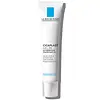What's inside
What's inside
 Key Ingredients
Key Ingredients

No key ingredients
 Benefits
Benefits

 Concerns
Concerns

 Ingredients Side-by-side
Ingredients Side-by-side

Glycerin 21%
HumectantWater
Skin ConditioningDimethicone
EmollientPanthenol
Skin ConditioningPentylene Glycol
Skin ConditioningC30-45 Alkyl Dimethicone
Skin ConditioningPolybutene
Sodium Citrate
BufferingPEG/PPG-18/18 Dimethicone
EmulsifyingCitric Acid
BufferingDimethiconol
EmollientPolysorbate 20
EmulsifyingMadecassoside
AntioxidantCaprylyl Glycol
EmollientSodium Hyaluronate
HumectantZinc Gluconate
Skin ConditioningCopper Gluconate
Skin ConditioningManganese Gluconate
Skin ConditioningTocopherol
AntioxidantGlycerin 21%, Water, Dimethicone, Panthenol, Pentylene Glycol, C30-45 Alkyl Dimethicone, Polybutene, Sodium Citrate, PEG/PPG-18/18 Dimethicone, Citric Acid, Dimethiconol, Polysorbate 20, Madecassoside, Caprylyl Glycol, Sodium Hyaluronate, Zinc Gluconate, Copper Gluconate, Manganese Gluconate, Tocopherol
 Reviews
Reviews

Ingredients Explained
These ingredients are found in both products.
Ingredients higher up in an ingredient list are typically present in a larger amount.
Panthenol is a common ingredient that helps hydrate and soothe the skin. It is found naturally in our skin and hair.
There are two forms of panthenol: D and L.
D-panthenol is also known as dexpanthenol. Most cosmetics use dexpanthenol or a mixture of D and L-panthenol.
Panthenol is famous due to its ability to go deeper into the skin's layers. Using this ingredient has numerous pros (and no cons):
Like hyaluronic acid, panthenol is a humectant. Humectants are able to bind and hold large amounts of water to keep skin hydrated.
This ingredient works well for wound healing. It works by increasing tissue in the wound and helps close open wounds.
Once oxidized, panthenol converts to pantothenic acid. Panthothenic acid is found in all living cells.
This ingredient is also referred to as pro-vitamin B5.
Learn more about Panthenol